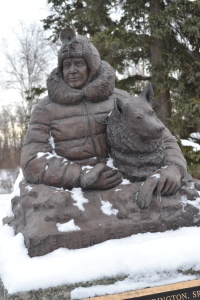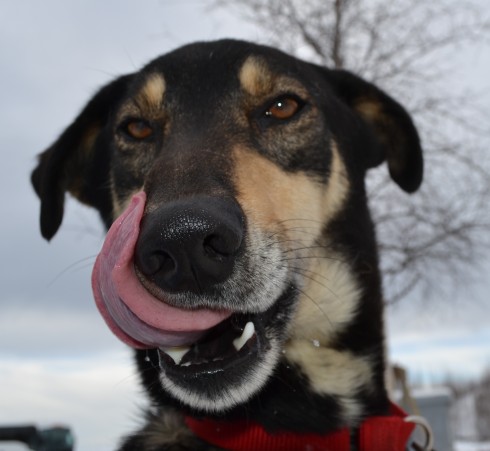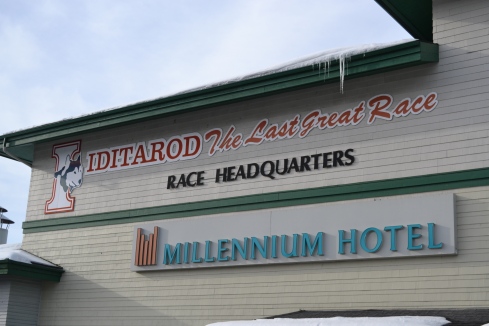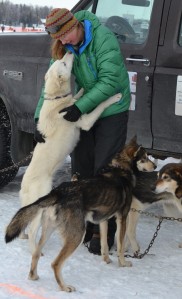You are currently browsing the category archive for the ‘Jennifer Reiter’ category.
As you know, I am always drawn to the stories behind the mushers and their dogs. Mikhail Telpin has a great story and he’s working to share it with students around the world. Mikhail is from Chukotka, Russia. He is spending his second winter in Willow where he is sharing kennel space with Joar Ulsom from Norway who is also racing in the Iditarod this year. The two are a part of Team Racing Beringia, which is a group of two mushers, their dogs, and an educator who are traveling via dogsled for two years over 3,500 miles across Beringia, the oldest inhabited Arctic region.
Mikhail made a stir at the vet checks on the Wednesday before the race when he dropped his Chukchi dogs from their dog boxes for the vets to examine. These are not your typical Alaskan Huskies we are used to seeing travel the Iditarod Trail! Mikhail is a subsistence hunter and these dogs are his life line partners in hunting and providing for his family. He hunts marine mammals and the dogs help him haul loads back to his family. The dogs are working dogs that have been bred and used by his people for thousands of years. The vets were very impressed with the dogs and commented how healthy they appeared. The dogs were so calm at vet checks. Mikhail doesn’t speak any English, so the vets have printed up cards with the phrases they think they will have to ask Mikhail in the checkpoints along the trail.
Mikhail is a renowned musher in Russia. In running the Yukon Quest last year, he had concerns about running his team in the dark because of the trees. He and his team don’t have trees in the coastal area where they live! He was afraid they would get lost among the trees and not be able to follow the trail. In that race he won the Red Lantern award and a special award for demonstrating the “spirit of the Yukon Quest.”
There is quite an international pool in the mushers this year: USA, Canada, Jamaica, Brazil, Norway, and New Zealand. There are wonderful opportunities to put a global spin on the race. I was intrigued by the idea that the oldest remains of sled dogs (over 8,000 years old) have been found in Beringia – which Chukotka and Alaska are a part of! There is also evidence that Togo – the lead dog for part of the Serum Run of 1925 was a Chukchi dog! This social studies lesson has students using online sources to compare the Chukchi dogs to the Alaskan Huskies. There are several options for additional writing assignments as well. From Russia With Dogs
Since Martin Buser is making headlines, I thought you’d enjoy this up close video of his Iditarod Race Team as they headed out on their last training run prior to starting this race.
Check out the comfy seat he has included on his sled! Sitting down and ducking behind the handle bars may help with wind resistance and therefore make things easier on the dogs in certain parts of the trail.
We will all just have to wait and see if his strategy pays off this year! It’s making for an interesting race so far!
When I went to bed last night, Martin Buser and Matt Failor were in positions 1 and 2.
When I got up this morning, they were in positions 42 and 43.
When I just checked, they were 50 and 51.
What on earth is going on? Have they given up? Are all the other teams passing them? Are they falling further and further behind?
And there you have the biggest critical thinking challenge you can present to your students in the context of this race. Trying to figure out what the data means, what it shows, and more importantly, what it doesn’t show.
There are hundreds of critical thinking problems to challenge your students using the race data as a source.
-
Ailey Zirkle left Rainy Pass 2.5 hours after Paul Gebhardt, but arrived in Rohn only 3 minutes after him. It took her 4 hours and 10 minutes to make the trip with an average speed of 8.4 mph. Paul took 6 hours and 43 minutes with an average speed of 5.21 mph. Are her dogs really that much faster than his? Maybe. But maybe he took a rest along the trail for a few hours. Remember, the speed is an average speed, so any rest time would just be rolled into the calculations.
- Aaron Burmeister spent 4 hours and 54 minutes in Rohn but Allen Moore only spent 22 minutes. Why? Maybe Allen prefers to camp and rest along the trail where it is quieter, where as Aaron prefers to break in checkpoints.
- Dallas Seavey has dropped two dogs. According to his Facebook page, one dog, Crockett, changed his gait and was dropped to prevent an injury. The other, Rody, stepped into a hole and pulled a muscle. Both of these dogs are leaders. How will this change his race? Check the data to see if this has slowed him down at all.
As for the original question about Martin Buser and Matt Failor. What the data doesn’t show is that they have both declared their 24 hours layover in Rohn. So yes, teams are passing them, and yes they are falling behind – for now. But remember, those other teams will have to do their 24 hour rest somewhere later down the trail. They will also have to make up the difference in start times during this layover… so Martin will be there for more than twenty-four hours.
I picked up a wonderful tip from Pam Verfaillie, an educator in Valdez, Alaska, about using the GPS trackers in classrooms that I never realized! If you click the tracker over to Satellite View you can zoom in and see some of the buildings in the checkpoints and can get a good idea of where the various teams have parked to rest. It’s really, really cool!
Challenge your students to develop theories about what is happening along the trail using the data! There really are no right or wrong answers, but it’s fun to think of all the possibilities!
Live from Headquarters…
Things are still bustling here at the Millennium Hotel in Anchorage. Even though the race has headed down the trail, things at the Race Headquarters have not slowed down too much.
The hotel serves as the base camp for several groups of volunteers. Walking through the hotel is a real treat for Iditarod enthusiasts. As you wander the halls you can overhear conversations about every aspect of the race from musher strategies, to logistics, to statistics, to history. If you listen really carefully, you can hear the different accents from the many different countries represented by this years’ volunteers, including South Africa, Australia, Canada, Great Britain and more!
On the first floor, the first stop for volunteers is the check-in desk. This desk opened a little over a week before the race began and will probably begin to close up shop in a day or two as most of the thousands of volunteers have had their paperwork processed through this desk by now. Further down the hall you come to the phone room. People can call into the phone room to leave messages for mushers as well as to get information. Sometimes the phones are manned by a group of students who answer questions of students who call in! Across the hall is the office for the Dog Drop yard. Dogs that are returning from the trail are kept here safe and warm until someone from the musher’s kennel can come and take them home. Dogs from mushers who may not be able to get there right away may be taken to the prison. Not because they are naughty, but to be cared for by the prisoners. The Dog Drop office is the one place you may not always find people…. not surprisingly, they are usually outside caring for the dogs! Here are some pictures of some dogs currently beging cared for by volunteers in the yard:
Elsewhere in the hotel are offices that house the Communications Department (they are the ones that figure out how information is gathered and reported from the checkpoints), the Stats Department (they produce the official records that people use to track the mushers), the Air Force Office (they manage the movement of people and materials by the Iditarod Air Force), the Education Office (they work with teachers and students who are learning about the race), and probably about a million more I am missing! At any given time, you can also find the Iditarod Insider camera crews, Jeff Schultz the official Iditarod photographer, checkers, race judges, bloggers, and the Teacher on the Trail™ moving in and out of offices getting their news fix or awaiting their next assignments. Several of these offices are bustling twenty-four hours a day. The mushers don’t stop and rest at night, so neither do the volunteers!
One of my favorite places to walk by in the hotel is the gigantic board where they record all of the official data from the race. You can check the standings anytime of the day or night!
It is amazing just how dedicated these volunteers are. Without them the race would not occur. It’s shocking how many pieces there are to the puzzle that need to be in place to make the Iditarod run smoothly. And smoothly it does move, year after year!
One man’s idea of what dogs are capable of doing as an attempt to honor their place in our world and their contributions to our life.
The dogs are the athletes.
They pour their heart and soul into doing what they love to do best.
It’s a privilege to be able to see them work their magic on the trail.
What if your teacher was absent because she was running the Iditarod? Well, it’s possible!
Angie Taggart is a teacher who is doing just that.
My class has been fortunate enough to get to know Angie well this year through emails and Skype and we are super excited to cheer her on to Nome in her second Iditarod. She is from Ketchikan and is actually the first person from her hometown to run in the Iditarod. She is familiar with this years’ Southern Route as she ran it in her rookie year (2009). She finished in 13 days, 1 hour, 49 minutes, and 24 seconds making her 43 out of 63 mushers.
We have learned a lot of new things about the Iditarod and mushing during the school year from Angie. We learned that if mushers don’t have enough dogs of their own to make a full team, they can lease dogs for the race season from other mushers. Angie will be running several leased dogs on her team this year. She reports that they get along well with her dogs and if they do get a little grouchy with each other, she just uses her “mean teacher voice.” My students also wanted to know if mushers have to carry plastic bags to scoop the poop from the trails and checkpoints. We know that where we live, people have to clean up after their dogs on walks. Angie taught us that no, they don’t worry about it on the trail, and in the checkpoints the volunteers take care of it!
I was lucky enough to get to see Angie several times this week to give her hugs and wish her luck on her adventure. She says that she is really excited to see how this race compares to her rookie run. She learned a lot running the Iditarod the first time and doing all her training and she’s looking forward to using that knowledge as she attempts her second race. She is also excited to see how the dogs do!
For the rookies, Angie offers this advice, “Never make a decision to stop the race until after you have eaten, slept and talked to a few people. With sleep deprivation you can make poor decisions. Also, have fun and enjoy every minute of it because you are a minority running a race of a lifetime!!”
CNN did a series on Angie when she ran her rookie race. You can see the videos HERE.
The Ceremonial Start for the 2013 Iditarod is in the history books. Today was all about the fans! Mushers and pups mingled with fans, reporters, volunteers, Idita-riders, and more as they awaited their time in the starting chute. After arriving at the first checkpoint, everyone loaded back into their dog trucks and headed home for one last night.
Here’s a little photographic timeline of the day’s events….
If today was about the fans, then tomorrow is all about the dogs, mushers and their relationships. It’s the beginning of something magical……
I think that on the eve of the Iditarod Ceremonial start, it’s appropriate to take a few minutes to remember the man who really got it all started, Joe Redington, Sr. He is known for many things including being the Father of the Iditarod, creating long distance sled dog racing, finishing the Iditarod fifteen times, and leading the first dog-team expedition to summit Mount McKinley.
it all started, Joe Redington, Sr. He is known for many things including being the Father of the Iditarod, creating long distance sled dog racing, finishing the Iditarod fifteen times, and leading the first dog-team expedition to summit Mount McKinley.
One rumor that Katie Mangelsdorf, Joe Redington, Sr. biographer, wishes would die is that the Iditarod was started as a memorial to the Serum Run of 1925. In that historic event, mushers delivered lifesaving medicine to Nome and helped to prevent a diphtheria outbreak.
She claims that Joe himself couldn’t even get that rumor to go away!
In fact, the true story behind the race is actually two-fold. The first thing you need to know about Joe is that he and his wife Vi lived right along the old historic Iditarod Trail. The trail was getting lost in the underbrush. He and Vi felt that this old mail and gold rush trail was just as important as the Lewis and Clark Trail or the Oregon Trail and strongly believed that it should be preserved. The second thing you need to know is that in the 1960’s when Joe was traveling through the villages, he noticed that the Alaskan Husky sled dogs were being replaced by snow machines. He loved these dogs and really thought they should be preserved also.
So he created the Iditarod as way to preserve the Iditarod Trail and to preserve the sled dog.
We have had the chance to hear Mrs. Mangelsdorf speak to us a couple of times this week about Joe, the race, and her book. She is so passionate about her subject matter and really makes Joe come to life as she tells his wonderful stories.
I had a chance to ask Mrs. Mangelsdorf what one thing she wished everyone knew about Joe. She replied, “Once Joe got an idea that he knew was possible, he just never let it go. His determination and perseverance has kept alive sled dog racing and this historical gold rush trail called the Iditarod Trail.”
So as the mushers prepare to begin their run to Nome tomorrow, I hope they all pause for a moment to give their thanks to Joe.
For more information Mrs. Mangelsdorf’s book click here: Champion of Huskies
“The best way to teach somebody something is to have them think they’re learning something else.”
~ Randy Pausch
I honestly cannot remember a time I did not use the Iditarod in my curriculum! I have been teaching since 1993, and I think the Iditarod has always been with me in one form or another. It’s a natural motivator for boys (and everyone else too!), full of dogs, adventure, spirit, competition and excitement. It’s a sporting event that makes boys rethink their favorite sports heroes. Here, men compete against women, twenty-five year olds compete against sixty year olds, and the ultimate goal for most is to just finish the race with healthy dogs. In last year’s race alone, we learned of a musher who saved a dog’s life by performing CPR, a musher who saved a child from one of the villages with his EMT training, a musher who donated money to fund a prize, a father and son who intentionally crossed the finish line together, and the youngest winner ever.
 My boys study Iditarod year round. It’s my classroom theme and we start talking about the dogs, the race, and the stories on the first day of school. In reading, we read several novels related to the race both as a whole class and in our monthly book clubs. Alaska and the race appear in my writing curriculum through assignments in poetry and original mythology. In Social Studies it is a reappearing theme through our units on Native Americans, Geography, and The Fifty States. The character traits of honor, integrity, excellence, humility, respect, and perseverance are highlighted. For us, our unit really hits its pinnacle from January to April as we look at the Iditarod in our math curriculum. Through the lens of the race we study area, perimeter, telling time, counting money, making change, calculating elapsed time, solving complex and multi-step problems, reading and interpreting line graphs, circle graphs, bar graphs, coordinate graphs, mean, median, mode and range, and more.
My boys study Iditarod year round. It’s my classroom theme and we start talking about the dogs, the race, and the stories on the first day of school. In reading, we read several novels related to the race both as a whole class and in our monthly book clubs. Alaska and the race appear in my writing curriculum through assignments in poetry and original mythology. In Social Studies it is a reappearing theme through our units on Native Americans, Geography, and The Fifty States. The character traits of honor, integrity, excellence, humility, respect, and perseverance are highlighted. For us, our unit really hits its pinnacle from January to April as we look at the Iditarod in our math curriculum. Through the lens of the race we study area, perimeter, telling time, counting money, making change, calculating elapsed time, solving complex and multi-step problems, reading and interpreting line graphs, circle graphs, bar graphs, coordinate graphs, mean, median, mode and range, and more.
The Randy Pausch quote above describes my Iditarod math curriculum perfectly. The boys think they are learning about the Iditarod, the dogs, the trail, and the mushers. They don’t realize the complex math and problem solving they are actually doing. In fact, one of my favorite stories from last year is the young man who expressed shock at the end of the unit when he was informed he would be having a math test. “What? We haven’t even done math for like three months.” Well, actually, yes you have…..







